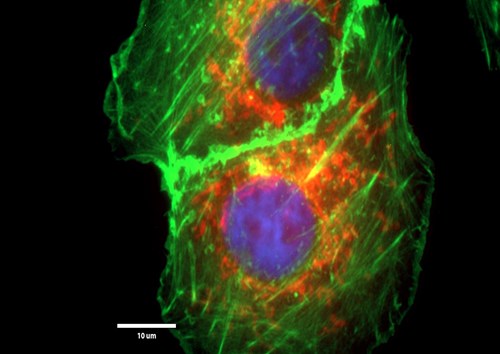Vero/hSLAM cell lines for SARS-CoV-2 research

ECACC Vero Monkey Kidney Cells. Actin cytoskeleton stained with phalloidin (green). Mitochondria labelled red and nuclei blue.
An array of SARS-CoV-2 virus variants have been isolated, propagated and used in in vitro assays, in vivo animal studies and human clinical trials. Observations of working stocks of SARS-CoV-2 suggest that sequential propagation in Vero cells leads to critical changes in the region of the furin cleavage site, which significantly reduce the value of the working stock for critical research studies. Serially propagating SARS-CoV-2 in Vero E6 cells leads to rapid increases in genetic variants while propagation in other cell lines (e.g. Vero/hSLAM) appears to mitigate this risk thereby improving the overall genetic stability of working stocks. From these observations, investigators are urged to monitor genetic variants carefully when propagating SARS-CoV-2 in Vero cells.
Professor Kevin Richards, Team Leader, High Containment Microbiology, UKHSA and author of: A cautionary perspective regarding the isolation and serial propagation of SARS-CoV-2 in Vero cells tells ECACC about his work during the pandemic:
"SARS-CoV-2 has played a big part in all our lives, especially within UKHSA laboratories. Producing laboratory grown stocks of SARS-CoV-2 that are as genetically authentic to circulating strains, is critical for evaluating therapeutics and monitoring diagnostic tools (e.g., Lateral Flow Devices). Reported in our publication the Vero/hSLAM cell line appears to improve the overall genetic stability of working SARS-CoV-2 stocks, in comparison to Vero E6 cells."
With thanks to Professor Kevin Richards, Team Leader, High Containment Microbiology, UKHSA
